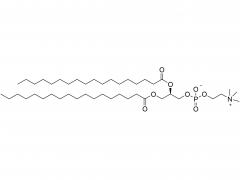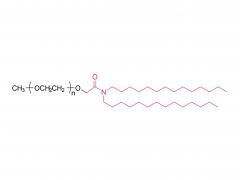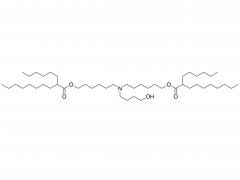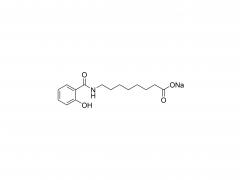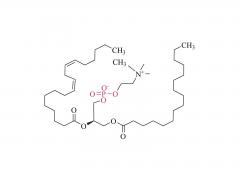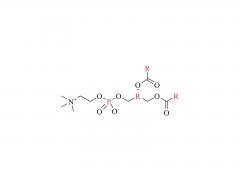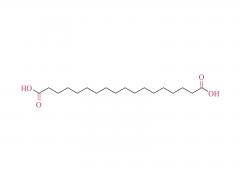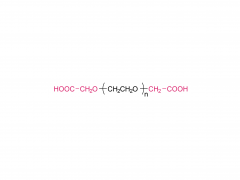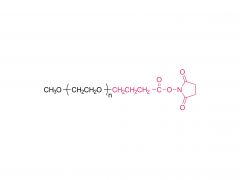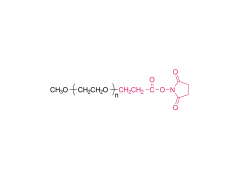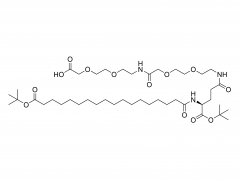DMG-PEG 2000
Le 1,2-dimyrisyl-rac-glycérol-3-méthoxy polyéthylène glycol 2000 (PEG), un excipient lipidique modifié par le PEG, joue un rôle crucial dans les systèmes d'administration de nanomédicaments. Son numéro CAS est 160743-62-4 et sa masse moléculaire est d'environ 2509,2 g/mol. Il se présente généralement sous forme de poudre solide blanche ou blanc cassé, ou de liquide visqueux (selon sa masse moléculaire). Ce composé est soluble dans les solvants organiques tels que le chloroforme, le méthanol et le DMSO. Il est également soluble dans l'eau chaude. Il est conservé à -20 °C, à l'abri de la lumière et de l'humidité, et doit éviter les cycles de congélation-décongélation répétés.
Du point de vue de sa structure moléculaire, le DMG-PEG 2000 est un polymère amphiphile dont la structure se divise en trois parties principales : une « tête » hydrophile, une « queue » hydrophobe et la liaison qui les unit. La partie hydrophile est composée de polyéthylène glycol à terminaison méthoxy (mPEG), d’une masse moléculaire typique de 2 000 Da. Cette longue chaîne de PEG hydrophile constitue le composant central et assure la stabilisation spatiale. La partie hydrophobe est composée de DMG, constitué de deux chaînes de DMG à 14 atomes de carbone. Ces chaînes agissent comme deux « ancres » qui s’insèrent fermement dans la bicouche lipidique des nanoparticules lipidiques (LNP), fixant ainsi la molécule entière à la surface des nanoparticules. La tête hydrophile et la queue hydrophobe sont généralement liées par des liaisons ester, qui présentent une certaine hydrolysabilité. Autrement dit, elles se rompent progressivement dans l’environnement in vivo, ce qui favorise le détachement de la couche de PEG et la libération du médicament.
La structure amphiphile du DMG-PEG 2000 lui confère des propriétés d'auto-assemblage uniques. En solution aqueuse, lorsque la concentration atteint la concentration micellaire critique (CMC), ses molécules s'auto-assemblent spontanément en micelles ou liposomes. La queue hydrophobe du DMG favorise cet auto-assemblage, tandis que la chaîne hydrophile du PEG forme une couche protectrice qui maintient la stabilité des micelles. Cette propriété d'auto-assemblage est essentielle pour son application dans les systèmes d'administration de médicaments. La couche d'hydratation du PEG du DMG-PEG 2000 réduit l'hydrolyse enzymatique et l'adsorption des protéines, et la chaîne d'acide gras saturé du DMG lui confère une grande stabilité thermique (température de transition de phase > 50 °C). Cependant, sa liaison ester peut s'hydrolyser dans certaines conditions ; il est donc nécessaire de le conserver dans un endroit sec et à l'abri de la lumière à -20 °C afin d'éviter l'oxydation à haute température ou les cycles de congélation-décongélation répétés.
Comparé à d'autres lipides pégylés, le DMG-PEG 2000 possède des propriétés uniques. Par exemple, contrairement au DSPE-PEG 2000, il présente des chaînes acyles plus courtes (C14 contre C18), ce qui lui confère un temps de résidence relativement plus court dans la bicouche lipidique. Cette caractéristique lui permet de se dissocier assez rapidement après que les nanoparticules lipidiques (LNP) aient atteint leur site cible, favorisant ainsi la libération du médicament. Il est à noter que sa demi-vie in vivo est généralement inférieure à 30 minutes, une caractéristique particulièrement importante pour la libération de vaccins à ARNm et de médicaments.
Du point de vue de la stabilité chimique, la chaîne PEG du DMG-PEG 2000 est liée au DMG par des liaisons ester. Ces liaisons s'hydrolysent progressivement in vivo, entraînant le détachement de la couche de PEG. Cette libération contrôlée constitue un avantage pour la conception des LNP, car elle permet la libération des médicaments encapsulés une fois arrivés au site cible et contribue également à réduire la réponse immunitaire au PEG susceptible de survenir lors d'administrations répétées. L'extrémité PEG du DMG-PEG 2000 est un groupe méthoxy (-OCH₃), chimiquement inerte mais capable de protéger cette extrémité de la chaîne contre la dégradation ou les réactions avec d'autres molécules, assurant ainsi la stabilité de la structure globale.
En conclusion, la structure chimique et les propriétés du DMG-PEG 2000 en font un composant indispensable des systèmes d'administration de nanoparticules lipidiques. Sa conception amphiphile ingénieuse, la longueur appropriée de sa chaîne hydrophobe et sa stabilité contrôlable contribuent conjointement à ses performances exceptionnelles dans l'administration de médicaments à base d'acides nucléiques.






